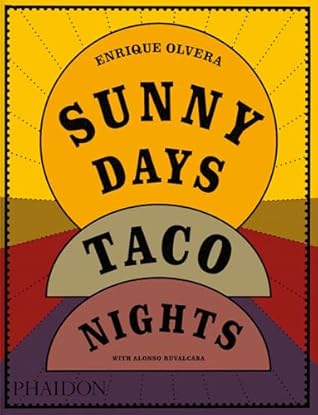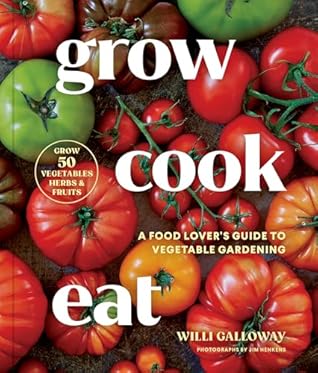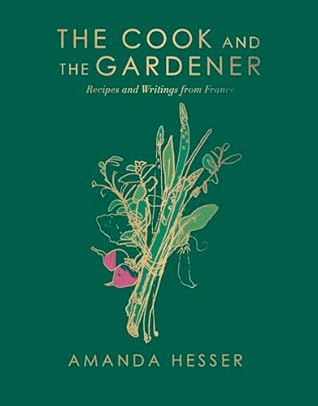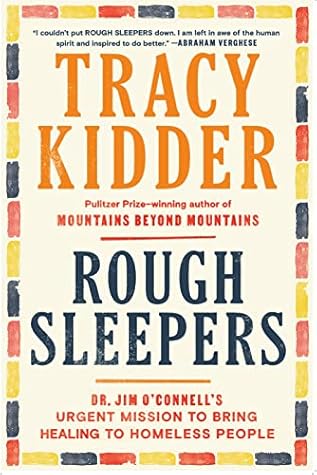
Rough Sleepers by Tracy Kidder
When Dr. Jim O'Connell graduated from Harvard Medical School, he was asked to defer a prestigious fellowship and help launch a grant-funded program to bring medical care to Boston's homeless population. He agreed and ended up finding his life's calling. Dr. O'Connell launched "the Program" from his initial involvement with a grant-funded clinic for the homeless in Boston that now hosts several clinics, a mobile outreach/clinic, and a building for respite care. He and a team of nurses, doctors, psychiatrists, and social workers try to help Boston's homeless have "continuity of care" despite their circumstances. There have been some success stories - former patients who got clean, got housing, and became productive citizens. Some of those success stories now work for the Program and give back to the organization that helped them. Sadly, the vast majority of the people the Program has helped are either dead or still homeless. So, what keeps Dr. O'Connell and his team going despite the hard work they are doing? That's what Tracy Kidder explores in this book. It's a portrait of Dr. O'Connell, the Program, and several memorable people from the Boston streets. This is obviously not a job everyone could do, but Dr. O'Connell makes it seem interesting and even though he rarely sees huge victories he focuses on the small victories and making each person he works with feel like a worthy human being. Eye-opening, sad, and heartwarming all at once, this is a unique book about a very unique doctor doing what he can to address the issue of homelessness in Boston.
Some quotes I liked:
"In the shelter clinics and on the van, Jim came face-to-face with dozens of people who hadn't been to a doctor in years, let alone a psychiatrist or dentist. He saw many rotted teeth and many cases of scabies and lice...At times Jim imagined that he and his colleagues were practicing something like wartime or post-earthquake medicine. It was as if he had been parachuted into another world that modern technologies had never reached. The situation was appalling, the work overwhelming. And, if he was honest with himself, utterly fascinating." (p. 42)
"Homelessness had a complex taxonomy. It included families and also many lone individuals, generally divided into four categories. There were the 'hidden,' such as the Street Team patient who slept in a rented storage locker. The 'transitional,' by far the most numerous, fell into homelessness only briefly, while the 'episodic' did so a few times a year. A smaller category - about 10 percent in 2018 - belonged to the 'chronic' category, living in constant or near-constant homelessness. That chronic group had two main subgroups - those who spent most of their nights in homeless shelters and those who slept rough, on pavement and park benches, in doorways, ATM parlors, tents on the outskirts of town...Some rough sleepers claimed their own distinction, labeling as 'snowbirds' those who slept out only in warm months and retreated to shelters in the winter. In fact, the difference was important. In Massachusetts, the people who lived mostly in shelters suffered a death rate about four times higher than that of the state's general adult population. But the people who stayed outside year-round - the Street Team's special patients, whom Jim had once imagined as 'hardy survivors' - died at about ten times the normal rate." (p. 55-56)
"By contrast, neither Jill nor the workers from Home Start had any experience in teaching domestic arts to rough sleepers, whose finely honed skills for outdoor living didn't help them indoors. Jim remembered a patient who actually pitched a tent in his apartment. Industrial cleaning was needed sometimes, not just because of partying but because many new tenants didn't know how to clean a stove or a bathroom. Most didn't know how to pay bills or shop for groceries, let alone cook. One freshly housed man, unable to sleep for a few nights, went back out to the streets and made a tape recording of the sounds of traffic and sirens, which he used as his lullaby, his antidote to indoor insomnia. People who had adapted to the exigencies of street life had no idea how to fill their time indoors." (p. 102)
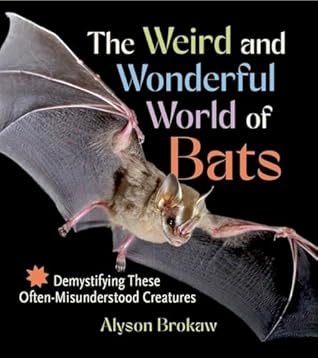
The Weird and Wonderful World of Bats by Alyson Brokaw
If you are interested in bats, this is the book for you. It is FULL of all kinds of information about every aspect of bats - how they use echolocation, how they fly, different roosting spots, what different kinds of bats eat, how they mate and raise young, etc. There is also a chapter on what we can learn from bats, how they are keystone animals, and what people can do to help bats. The book is full of lots of color photos of a variety of bats. The book is pretty easy to read, but some sections are a little science-heavy and may not be interesting to every reader. It reminded me a lot of The Owl Handbook by John Shewey - it's the same size book, full of color photos, and a mix of science and easily readable non-fiction writing. I really enjoyed this one and I hope to add a bat box to my back yard this year so that I can promote more bats in my yard.
Some quotes I liked:
"In 1953, [George] Griffin dragged a literal truckload of equipment to a pond near Ithaca, New York, and listened to bats as they hunted insects above the water. He noticed that foraging bats were adjusting their sound production patterns in flight. At this point, no one had suspected that bats could use echolocation to detect and capture small, fast-moving insects on the wing. Even Griffin himself was surprised, later writing that 'echolocation of stationary obstacles had seemed remarkable enough, but our scientific imaginations had simply failed to consider...this other possibility with such far-reaching ramifications.'" (p. 27)
"Bats can process acoustic information from echoes with impressive speed and accuracy. A recent study found that Mexican free-tailed bats can accurately discriminate between different textures. Bats were trained to associate coarser grit sandpaper with a mealworm reward. They easily discriminated between ten different sandpaper comparisons...Put another way, these bats were able to differentiate textures using sound with about the same accuracy of a human hand discriminating texture using touch." (p. 35-36)
"Two species of bats deserve special recognition for their ability to ambulate on the ground: the New Zealand lesser short-tailed bat and the common vampire bat...To study how these bats move on the ground, researchers trained them to walk and run on a treadmill while recording them using high-speed video. Both bat species were observed to use a lateral sequence walk, a widespread form of walking in terrestrial animals where the left forelimb moves forward at the same time as the right hindlimb. Common vampire bats were notably very smooth during this movement, keeping their body at a constant height to move with a smooth, horizontal, catlike gait." (p. 104) [There is also a picture of a bat on a treadmill in the book!]
"As of 2013, more than 500,000 bats were estimated to be killed annually from wind farms in Canada and the United States...Bats either die by colliding with the turbines - which at the tip are moving at more than 200 miles per hour - or from trauma associated with rapid pressure changes near the turbines." (p. 240)
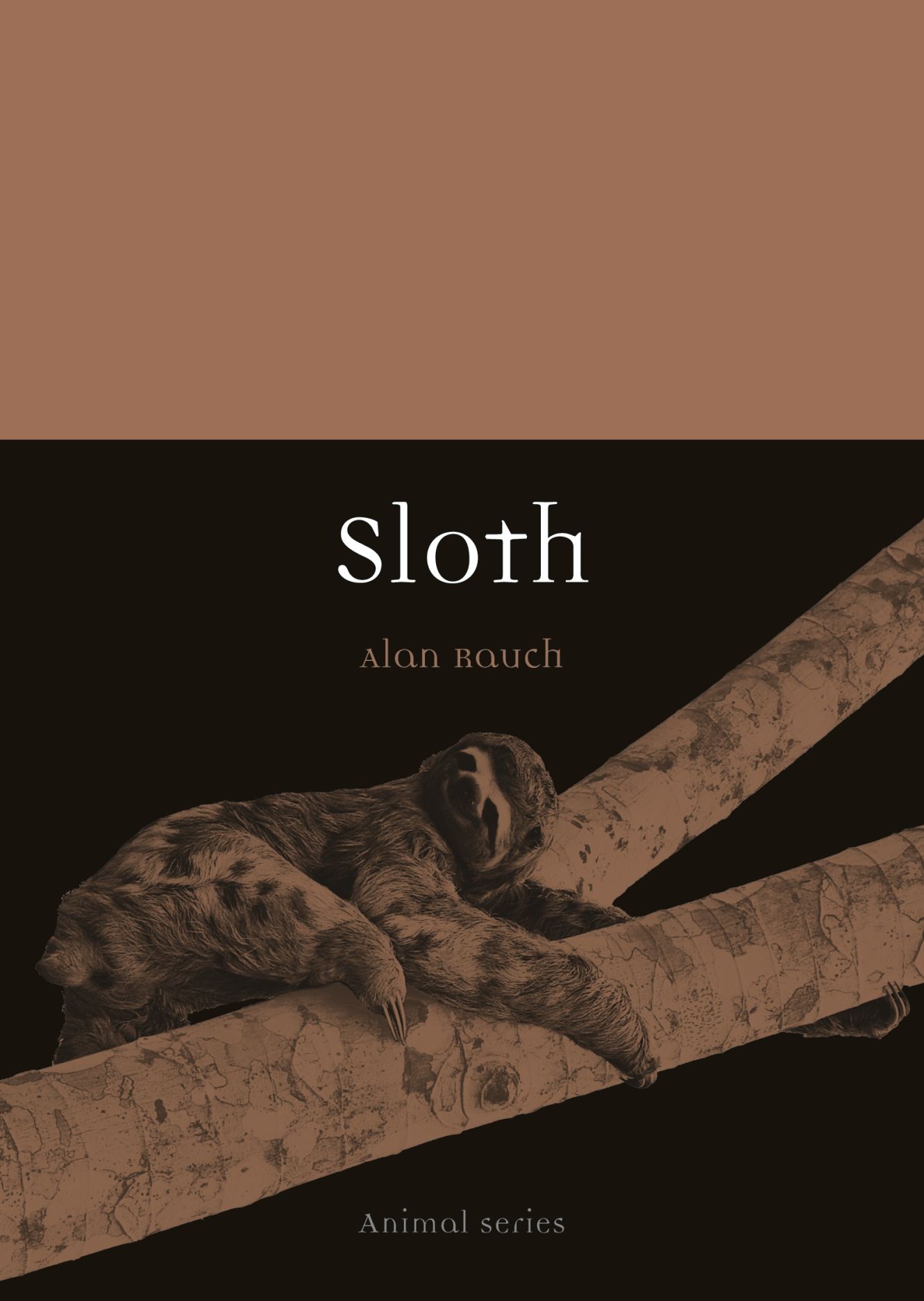
Sloth by Alan Rauch
This is a unique book all about sloths. It covers the modern sloth, the giant ground sloth that existed during the time of the dinosaurs, sloth anatomy, sloth (as in one of the seven deadly sins), sloths in current culture, and sloth conservation. While I LOVE sloths and was excited to read all about them, this book was disappointing. I felt like there was WAY too much focus on historic/giant ground sloth and not as many pictures as there could have been. I also feel like the chapter on sloth as one of the seven deadly sins didn't need to be included. That has nothing to do with the animal sloth. There was some good information but it wasn't amazing. I did appreciate that the author reiterated that any entity that allows people to hold sloths for money is NOT good for the sloths. Seeing them in person can be done but it is not good for them to be held, especially by hundreds of tourists/strangers.
"Recent studies have uncovered 'rod monochromacy' as part of the evolutionary development of sloths. What that means is that sloths, over time, have lost the cones that enable color vision and so the animals can only see the world in black and white." (p. 62-63)
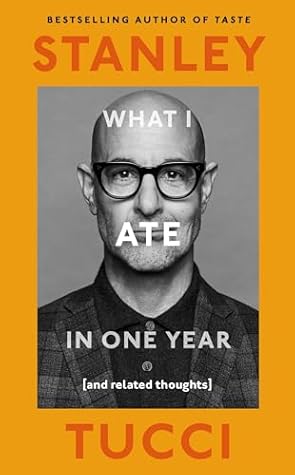
What I Ate in One Year by Stanley Tucci
I really enjoyed Stanley Tucci's book Taste but this one was not as enjoyable. It is less a food memoir and more of a food diary with a few extra thoughts thrown in some of the entries. I like Tucci's writing and he is funny - there were several times I laughed out loud reading. But there were also several times he seemed to imply his wife wasn't working but out cheating or something. I'm like did I miss something? Is this a weird on-going joke? Not sure if it's dig/joke because of their age difference, but those couple instances were off putting to me. The main themes I got were Tucci eats a LOT of pasta - like more than you can imagine, a lot and cooks a LOT - both for his family and dinner parties, on vacation, etc. At times the format did get old, but I did finish it. Would I highly recommend it or read it again? Probably not. But he is pretty funny and I'm glad I finished it.
Some quotes I liked:
"I like to make tomato sauce whenever I return home after a trip, or when I arrive at a vacation home or wherever I'm staying while filming. I find it grounding. After the sauce has cooked for even just a few minutes, the new space smells more like home." (p. 66)
[On celebrating Thanksgiving even though they live in London] "Why do we do it? Because we like turkey? No. Frankly those busty, fatless fowls are a pain in the ass to cook, even though somehow Felicity has found a method of cooking them brilliantly. But we do it, we celebrate it...[because] the idea of communing through food is beautiful and something to be celebrated. People always think of the turkey when they think of Thanksgiving, but to me it's the side dishes, the trimmings, those ubiquitous 'fixin's', that make that day's meal wonderful rather than the big bird itself." (p. 293)
"We watched a couple of short Christmas films. I tried to find the ones I grew up with made by Rankin/Bass in the sixties, like Rudolph and the one about how Santa came to be, but to no avail. I couldn't even find the original Grinch narrated by Boris Karloff. I am sure they're all lurking out there somewhere in the ether, but I am simply not capable of finding the right button on the right remote to bring them back for a nostalgic holiday visit."
From the Ground Up: the women revolutionizing regenerative agriculture by Stephanie Anderson
I was REALLY looking forward to reading this one but I had to quit. After reading the first couple of chapters I realized the author was hardly talking about the women-run farms that were supposed to be the focus of each chapter. It was more of a few pages about that farm and then the majority of the chapter about the evils of White men, industrial agriculture, colonization, how BIPOC people are discriminated against, etc. Not to say that what she was talking about wasn't true but I thought the point of the book was how these women are "revolutionizing regenerative agriculture." Not beating us over the head about how disadvantaged they still are in this field. This could have been an amazing book. Instead it was a lot of virtue signaling from a White woman. I would have much rather actually gotten more of the stories of these women and their regenerative farms.
